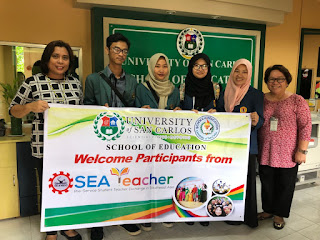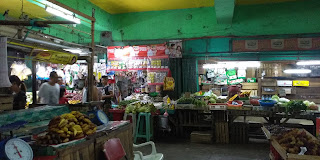School Profile: University of San Carlos, Cebu City, Philippines
The University of San Carlos
(USC or colloquially shortened to San Carlos) is a private, Catholic and
research university in Cebu City which is administered and managed by the
Society of the Divine Word since 1935. It provides basic education (Montessori
academy, grade school, and junior high school), senior high school,
undergraduate and graduate studies higher education.
Administered by the Society of
the Divine Word (Societas Verbi Divini, SVD) since 1935, the University of San
Carlos (USC) traces its roots to the Colegio de San Ildefonso founded in August
1595 in Cebu City. The school closed in 1769 following the expulsion of Jesuit
priests from the Philippines, and was reopened in 1783 as Colegio-Seminario de
San Carlos which operated until the Colegio split from the seminary in 1930.
Following another brief closure during World War II, Colegio de San Carlos
became a University in 1948.
USC consists of five campuses
in different areas of Metro Cebu – the Downtown Campus (formerly the Main
Campus) along P. del Rosario St.; the Talamban Campus (TC) along Gov. M. Cuenco
Ave., Brgy. Talamban; the North Campus (formerly the Boys High Campus) along
Gen. Maxilom Ave; the South Campus (formerly the Girls High) along corners J.
Alcantara St. (P. del Rosario Ext.) and V. Rama Avenue; and the newest is the
Montessori Academy along F. Sotto Drive (at the back of USC North Campus).
 |
| University of San Carlos BED - South Campus |
Student support in the
University includes an international students’ office, online enrolment,
dormitories, numerous cafes and canteens, and a transport system within
Talamban Campus. USC has more than 600 undergraduate and graduate scholars at
any given time. Since 2014, USC has been designated as a Donee Institution by
the Philippine Council of Non-Governmental Organization Certification (PCNC).
Student support in the University includes an international students’
office, online enrolment, dormitories, numerous cafes and canteens, and a
transport system within Talamban Campus. USC has more than 600 undergraduate
and graduate scholars at any given time. Since 2014, USC has been designated as
a Donee Institution by the Philippine Council of Non-Governmental Organization
Certification (PCNC).
There are some programs of academic and curricular which are offered by the
different school in the university, the following are:
·
Basic
Education:
a)
Pre-School/Montessori
Academy
b)
Grade
School (Grades 1-6)
c)
Junior
High School (Grades 7-10)
d)
Senior
High School (Grades 11-12)
·
Baccalaureate
Programs:
a)
School
of Architecture, Fine Arts and Design
b)
School
of Arts and Sciences
c)
School
of Business and Economics
d)
School
of Education
e)
School
of Engineering
f)
School
of Health Care Professions
g)
School
of Law and Governance
Vision:
The University of San Carlos sees:
a.
A WORLD
where the darkness of sin and the night of unbelief vanish before the light of
the Word and the Spirit of grace.
b.
A SOCIETY
where citizens are competent, noble in character and community-oriented:
·
What they
know, they apply justly and honestly...
·
What they
do not know, they seek to learn..
·
What they
do not have, they endeavor to acquire...
·
What they
have, they share.
Mission:
The University of San Carlos is a Catholic institution of learning that
embodies the principles of academic discipline of San Carlos Borromeo and the
missionary charisma of the society of the Devine Word (SVD).
We aim to develop competent and socially responsible professionals and
life-long learners in an environment that fosters excellence in the academic
core processes of teaching-learning, research, and community extension service.
Our mission is to provide timely relevant and transformative academic
program responsive to the needs of the local, national and global communities
in a rapidly changing world.
Academic Support System
In the south campus, there are total 5 buildings for the classroom and one building is the cultural center. The cultural center is called Rudolf Rahmann and it is located right behind our room, we were staying in the guest rooms on the fifth floor of the school building. For the college they have their own cultural center called Anthony Buchchik Hall which is located on the first floor in the first building.
Right in the middle of the college building and the BED building is the courtyard where they have their Missa and flag ceremony. Then right in the middle of the BED buildings is the little park with a big Jesus statue right at the central.
There are also basketball yard, playground, cafeteria, parking lot, a park around the cultural center which is near the side gate. In the buildings, there are classrooms for the BED students and only a few for the college students, a church, faculty rooms for the teachers and it's different for every level, food stands along the hallways, a cooking lab, a computer lab, a drafting lab, a biology lab, sewing lab, and a chemistry lab and so many other rooms to support the teaching learning process.
Teaching system
University of San Carlos has BED system that consists of:
1. Montessori Academy
2. Elementary School 1st – 6th grade
3. Junior High School 7th – 10th grade
4. Senior High School 11th – 12th grade
The school starts from 7.40 am till 4.50 pm. For Junior High Schools, in general, they have 8 subjects each day which each period consists of 60 minutes. But every Friday they only have 5 subjects because the school ends at 3.50 pm.
Every Tuesday they have flag ceremony from 7.15 – 8.40 am. They also have cultural day every beginning of the semester. These are the subjects that they learn in grade 10:
1. Math
2. A.P
3. Health
4. Science
5. CIF (Religion)
6. English
7. Filipino
8. Filipino English
9. TLE (Technology and Livelihood Education)
1. Arts
1. Music
 |
| One of the students' time-table |
And also for my mentor, Mrs. Postrano, she handles 5 out of 8 sections; they are 10BMHS, 10FJK, 10FJJ, 10SJF, and 10FAB.
 |
| Mrs. Postrano,s schedule |
For English area
Subject orientation
a. Energizer activity (every beginning of the class)
b. Getting To Know You (GTKY) Activity
c. Course Overview (Refer to Your CD): Grade Level Standard, Common Learning Targets (CLT) from 1rt to 4th quarter, Performance tasks.
d. Grading system:
o Written works(quizzes and practices) : 30%
o Performance (presentation and participation in class) : 50%
o Quarterly assessment : 20%
e. Requirements (include textbook and references)
f. Invention Program: Remedial class every Thursday and consultation period after class.
g. House Rule
h. Diagnostic Test/Pre-test will be given in the beginning of the lesson
i. Post test will be given on Friday
Material and other learning sources
 For English for grade 10, they only use one textbook that is provided by the school and one Greek Mythology novel that they have to get it by themselves in the bookstore outside of the school, but the teacher also uses sources from the internet as her slides.
For English for grade 10, they only use one textbook that is provided by the school and one Greek Mythology novel that they have to get it by themselves in the bookstore outside of the school, but the teacher also uses sources from the internet as her slides.
Measurement and Evaluation System
Grading system: Averaging
Criteria:
o Written works(quizzes and practices) : 30%
o Performance (presentation and participation in class) : 50%
o Quarterly assessment : 20%
Deportment Grade:
Student’s conduct is graded based on the school core value such as: Integrity, Excellence, Commitment, Social Responsibility, Evangelization, and Leadership Each core value is given 10 point as perfect score. Then the total points/raw score is transmuted into numerical grade. The numerical grade will then be expressed in letter grade as reflected in the grade slip and report card.
There are post-test in every lesson and only if they got good scores in those will be recorded as written works. But if there is a student whose score is under standard they will have additional test so that their average score reaches the minimum standard.
Also my mentor said that they adapted quarter system so then they had four quarter in a year. They had examination every quarter and students’ evaluation result will be accumulated in the final quarter. It will be decided which the students will be up to the next level/grade. They had to repeat the class if they didn’t pass minimal 2 subjects and they take it when the summer holiday.
Curriculum
Basic Education University of San Carlos used K to 12 Curriculum.
K-12 is a program that covers kindergarten and 12 years of basic education to provide sufficient time for mastery of concepts and skills, develop lifelong learners, and prepare graduates for tertiary education, middle-level skills development, employment, and entrepreneurship.
Teaching Plan (of my major)
Pedagogical Contents
For English, there are strategies and assessment method that are already arranged by all the English teachers in the school. They use it depend on the materials/topic they have teach to the students because every topic possibly does not suit with every strategy. So each topic might have different strategies.
As what I have observed in the class, the teaching method mostly applied is teacher-center. The teacher explained the materials through slides and barely used any other kind of media except for the board which was only used once or twice.
For activities that encourage the students to take part in the class, the teacher usually made discussion group or partner work to solve the problems that were given by the teacher. Then after they had discussion group the teacher also gave individual exercises or assignments.
The sources of learning they have are textbook that provided by the school and the novel. The teachers and the students have the same textbook. The technology used is TV as the projector, speaker, etc.
The authentic assessment can be contained in the textbook or may be made by the teacher. The assessment may be printed and copied then were given by the students or teacher can write and display the question on the board.






Komentar
Posting Komentar